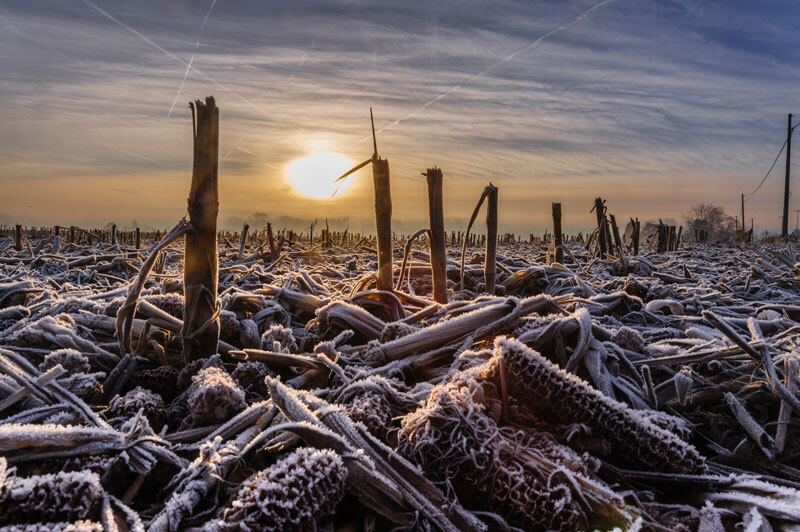Have you ever walked outside on a cold winter morning and noticed that your plants have moved? Or that your deck has shifted and some of your stonework isn’t quite as straight? You aren’t imagining things; this natural occurrence is called frost heave.
What is Frost Heave?
Frost heave occurs in the cold seasons as the ground goes through periods of freezing, thawing, then refreezing. As cold temperatures hit, liquid below the frost line is drawn to the surface. The liquid then freezes, creating layers of ice. This natural event causes frosted soil to expand and contract, ultimately affecting your landscape design. For this to happen, one or more conditions must be present:
- Freezing temperatures penetrate the top layer of the soil
- Moisture must be present in the soil
- Fine-grain soils that are predisposed to heave due to high moisture content such as silt, loam, and clay are most susceptible
- Ice lenses – bodies of ice formed when moisture, soil, and rock accumulate and continually stack above the frost line.
The Damage of Frost Heave
Areas that experience long seasons of hard-frost temperatures are often negatively affected. Water in the ground and all of the contents in it freeze, expanding and causing an upward lifting of plants, soil, roots, and rocks. Stones and other larger particles work their way to the top of the ground as this process repeats itself throughout the winter months.
If your original landscape project isn’t designed for the cold, serious issues are inevitable. You may experience damage to your walkways, driveway, plants, and even home or building. In some cases, the ground may collapse when the frost begins to thaw.
When the conditions are ideal, heaving can occur in all types of soil. Learn how to fix frost heave damages on your commercial property or residential landscape by getting expert advice from the professionals at Sponzilli Landscape Group.
Preventing Frost Heave
When it comes to your landscape, frost heave can be a challenge to prevent. However, it is possible. Although you cannot stop it altogether, you can minimize any damages. With a little planning and vigilance, mitigating frost heave is simple.
Protecting Your Plants
You work hard to maintain a beautiful garden. The winter season shouldn’t be the death of all of your efforts. With some time and a lot of attention, you can prevent your lively garden from becoming a frozen plant graveyard.
Hardiness
Plants based on your “hardiness zone” should be able to tolerate the lowest temps in your area. If you’re planting in the fall, plant perennials at a minimum of 6 weeks in advance of the first frost. This will allow the plant to put down a sound root system.
Vulnerable Plants
Diligently monitor susceptible plants. If heaving is starting to occur, you can gently step the soil back down to straighten the plant. You should also add a layer of soil, then mulch to help regulate soil temperature.
Proper Drainage & Insulation
Proper drainage is critical to preventing frost heaves. If you take the time to amend the soil with organic matter two times a year, spring and fall, you’ll save a lot of hard work in the winter. Organic matter will decompose, loosening the dirt, promoting proper drainage.
After the first hard frost, add 4-6″ of mulch around your plants. Use organics, such as:
- Hay
- Pine
- Straw
- Grass
- Clippings
- Leaves
- Trimmings
- Compost
- Pine bark
- Nuggets
- Cypress mulch
When it comes to choosing organic material for your plants, you really can’t go wrong. Any form of organic mulch will supply a layer of insulation for your plants and help prevent them from moving. While you’re at it, you may even consider laying newspaper around your plants before adding organic material. Newspaper works great as a weed barrier and provides more insulation just beneath the mulching layer. The newsprint is organic and breaks down very quickly, so you don’t have to worry about any harm to the environment.
Protecting Your Hardscape
The plants in your garden aren’t the only things you should be concerned about when it comes to frost. Your deck, concrete path, and any other hardscape project can get damaged from frost heave as well. That’s why it’s important to utilize trained professionals when creating your landscape design. They will incorporate proper drainage techniques along with native plants to construct an outdoor living space that will last.
Regardless of the type of installation, every landscape addition should be protected from frost heave. In most instances, you can protect your hardscape by replacing fine-grain soil with coarse granular materials.
Don’t let frost heave be the death of your landscape design this winter season. For all of your landscaping needs, including winter landscape protection, contact Sponzilli Landscape Group.




